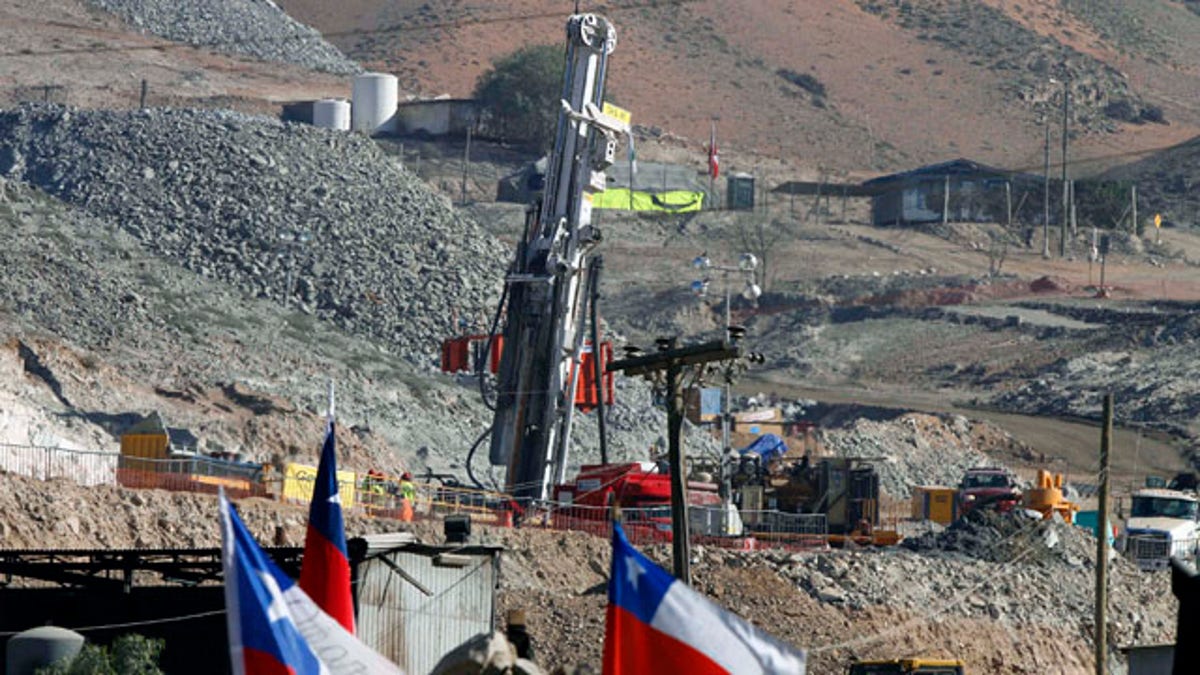
September 9: A drill is used in the rescue operation of trapped miners at the San Jose mine in Copiapo, Chile. The thirty-three miners have been trapped deep underground in the copper and gold mine since it collapsed on Aug. 5. (AP)
SANTIAGO, Chile – SANTIAGO, Chile — Drilling equipment pounded its way into one of the caverns where 33 miners have been trapped for a month and a half, completing a bore hole ahead of schedule Friday and raising hopes that the men can be pulled out earlier than expected.
The 12-inch-wide drill guided by a pilot hole half its diameter reached 2,070 feet beneath the surface, puncturing the top of a passage near the chamber in the San Jose copper and gold mine where the men have taken refuge.
The next step is to place a wider drill on the rig and start a hole 28 inches across — wide enough for the miners to get out.
Video shot by the miners and released by the government later Friday showed scenes of bedlam below when the drill broke through, sending a shower of water and rock down into the chamber. "Viva Chile!" the miners cried, hugging each other and posing for the camera with broad smiles and headlamps beaming.
"We are extremely excited by what has been done today," said Mario Sepulveda, who has become a spokesman of sorts for his fellow miners and relays most communications from the depths.
Now "it's time for the third and final stage" of the rescue, another unidentified miner said into the camera.
The government previously said it would take until early November to rescue the miners under the most optimistic scenario, but Mining Minister Laurence Golborne said Friday that now "we're a little bit ahead." The earlier estimate had built in the possibility of more setbacks than the effort has seen so far, he said.
Golborne did not provide a new estimate.
The government did not provide any reaction from the miners on Friday's breakthrough; it has made a habit of waiting a day to release video of the trapped men.
The miners have endured sweltering conditions for weeks, and the discipline and resiliency they have shown through their ordeal has been a point of pride among Chileans — perhaps especially so as the nation celebrates the bicentennial of its independence Saturday.
The miners celebrated the bicentennial Thursday, with beef and empanadas, and they decorated their chamber with a plastic Chilean flag.
Two rigs have been drilling holes separately to ensure that rescuers wouldn't have to start from the beginning if a major problem arose. A third, much larger rig is to begin drilling Monday.
The piston-driven air compression drills being used on the Schramm T-130 rig that broke through the passage chips away at rock like a jackhammer. Its hammers are made of of diamonds, tungsten carbide and other alloys. The 12-inch drill was down for several days after a bithead broke — but still beat the more traditional competing drill down to the trapped miners.
Brandon Fisher, whose American company built the drills used on the T-130, said in a telephone interview with The Associated Press that the piston-based drilling system that will dig the larger hole will have four hammers instead of just one. Each hammer pounds independently, an average of 1,500 times per minute, he said.
The rest of the process will take weeks, but Fisher, of Berlin, Pennsylvania-based Center Rock, Inc., said he could not estimate how long.
"There's just no way of knowing. We're drilling in extremely hard rock," Fisher said. "It's a volcanic conglomerate with a very high silica content and silica is the most abrasive substance that can be found in rock."
Once the larger hole is dug, it will be reinforced with a metal sleeve. The miners will be hoisted up in an steel "escape capsule" that is still being designed but will be fitted with oxygen tanks and a communications system.
Widening such a deep hole has its dangers, including cave-ins that could trap the drill and halt the operation.
"By no stretch of the imagination is this a cakewalk," said Fisher.
The 38-year-old said he'd been working nearly straight for the past two weeks and was looking forward to eating and sleeping before resuming work.
"We hope to be drilling (again) in the next couple of days," he said.
Three smaller holes drilled earlier have allowed rescuers to supply the men with food, water, medical supplies and extra air, as well as lines to communicate with relatives and officials above.
The trapped miners work for a company with a history of safety violations that has pursued bankruptcy protection since the collapse and has said it can't afford to pay the men. They have been offered new jobs with larger mining companies in Chile that apply modern technology and safety standards to extracting the copper, gold and other minerals that provide for about 40 percent of the government's revenue.
